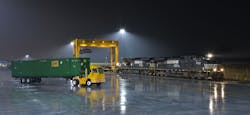Intermodal may be poised to win more freight away from TL carriers in the second half of the year due to current and impending federal regulatory efforts plus and growing driver shortage that are combining to reduce both truck productivity and capacity.
“It is clear to us that TL carriers serving long haul trucking lanes … are having difficulty finding sufficient numbers of high-quality drivers to seat their trucks,” said Ron Sucik, founder of RSE Consulting, during a webinar last week hosted by Wall Street investment firm Stifel Nicolaus.
“Driver quality regulations, such as the CSA [Compliance Safety Accountability] program, should remove a portion of the drivers from the industry while the upcoming hours-of-service [HOS] regulations should reduce the productivity of the remaining drivers,” he added. “The mandatory overnight rest periods will also take trucks off the road during the most productive and least congested times of the day.”
In sum, Sucik noted that the productivity “hits” from those two sets of regulations is estimated to be 3% and potentially 3% to 5%, respectively.
Sucik also said current driver pay is not high enough to encourage new entrants into the industry, pointing to U.S. Bureau of Labor Statistics wage data that indicated U.S. tractor-trailer driver wages only averaged $39,830 in 2011, significantly below the overall U.S. average annual wage of $45,230 that year.
As a result, truck capacity is at a four-year low, and by the second half of 2012 a shortage of truck capacity could become acute, he stressed – encouraging many shippers to shift more freight away from trucks to truck-rail intermodal service, even for shorter lengths-of-haul than in the past.
“The fastest growing intermodal length of haul is in the 500 to 750 mile range,” Sucik said. “Intermodal has about a 20% share with trucking in tonnage with lengths of haul over 1,000 miles and it has just over 10% market share with truck in tonnage with lengths haul between 500-750 miles. [But] the 500-750 mile intermodal length-of-haul lanes represent a market that is much less mature than the lanes that contain 2,000-plus mile lengths of haul.”
He added that recent intermodal investment by railroads has been concentrated in areas that will go toward serving origin-destination pairs that were not historically served well by intermodal; areas such as Norfolk Southern's Crescent Corridor, which is intended to take trucks off the roads, and CSX's North Baltimore-Ohio intermodal terminal which is intended to open up new intermodal origin-destination pairs.
Sucik also emphasized that most of the large intermodal providers have added very significant volumes of domestic containers within the past year – with J.B. Hunt being the most significant – so a shortage of intermodal capacity should not develop.
He added that the intermodal trailer/container fleet increased by 4,500 units in 2012, with the total number of domestic containers in the U.S. – managed by either railroads, motor carriers, or third party logistics provides (3PLs) – totals about 215,000 units, up 14,500 units 2011.
“[Thus] there also does not appear to be a major risk of availability issues with intermodal cars for the 2013 peak intermodal shipping season,” Sucik pointed out.
About the Author
Sean Kilcarr
Editor in Chief
Sean Kilcarr is a former longtime FleetOwner senior editor who wrote for the publication from 2000 to 2018. He served as editor-in-chief from 2017 to 2018.
